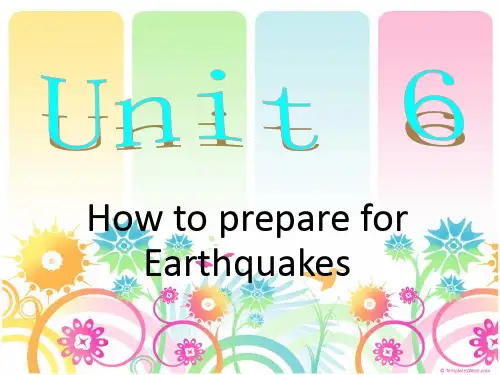How to Prepare for Earthquakes Unit 6
- 格式:ppt
- 大小:2.09 MB
- 文档页数:11
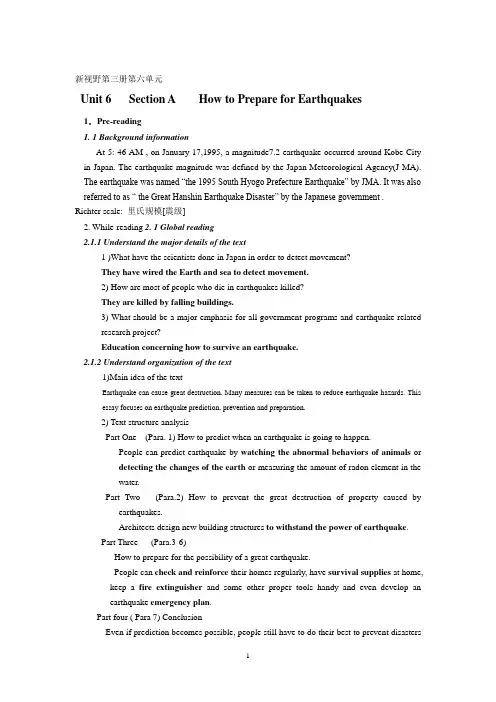
新视野第三册第六单元Unit 6 Section A How to Prepare for Earthquakes1.Pre-reading1. 1 Background informationAt 5: 46 AM , on January 17,1995, a magnitude7.2 earthquake occurred around Kobe City in Japan. The earthquake magnitude was defined by the Japan Meteorological Agency(J MA). The earthquake was named “the 1995 South Hyogo Prefecture Earthquake” by JMA. It was also referred to as “ the Great Hanshin Earthquake Disaster” by the Japanese government .Richter scale: 里氏规模[震级]2. While-reading 2. 1 Global reading2.1.1 Understand the major details of the text1 )What have the scientists done in Japan in order to detect movement?They have wired the Earth and sea to detect movement.2) How are most of people who die in earthquakes killed?They are killed by falling buildings.3) What should be a major emphasis for all government programs and earthquake-relatedresearch project?Education concerning how to survive an earthquake.2.1.2 Understand organization of the text1)Main idea of the textEarthquake can cause great destruction. Many measures can be taken to reduce earthquake hazards. This essay focuses on earthquake prediction, prevention and preparation.2) Text structure analysisPart One (Para. 1) How to predict when an earthquake is going to happen.People can predict earthquake by watching the abnormal behaviors of animals ordetecting the changes of the earth or measuring the amount of radon element in thewater.Part Two (Para.2) How to prevent the great destruction of property caused by earthquakes.Architects design new building structures to withstand the power of earthquake.Part Three (Para.3-6)How to prepare for the possibility of a great earthquake.People can check and reinforce their homes regularly, have survival supplies at home, keep a fire extinguisher and some other proper tools handy and even develop anearthquake emergency plan.Part four ( Para 7) ConclusionEven if prediction becomes possible, people still have to do their best to prevent disastersby improving building structures and by being personally prepared2. 2 Detail reading2. 2. 1 Words and phrases1) detect ( L.3 )在死者的胃里发现了少量的毒药。
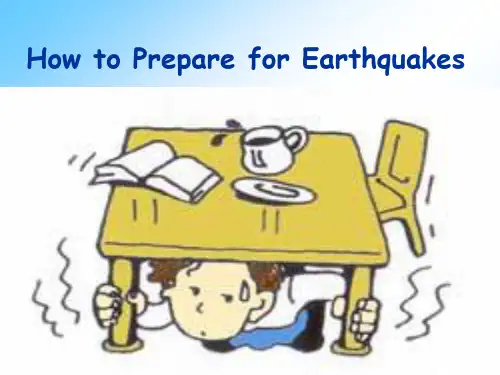
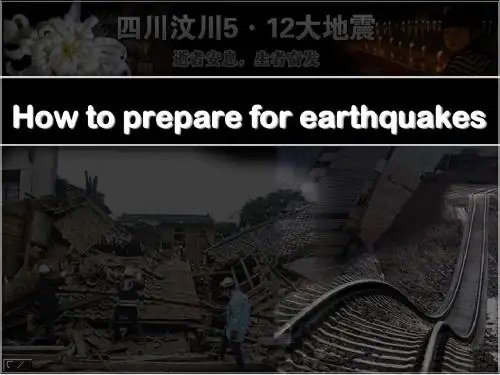
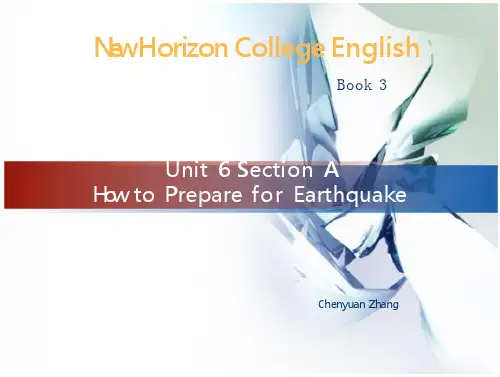
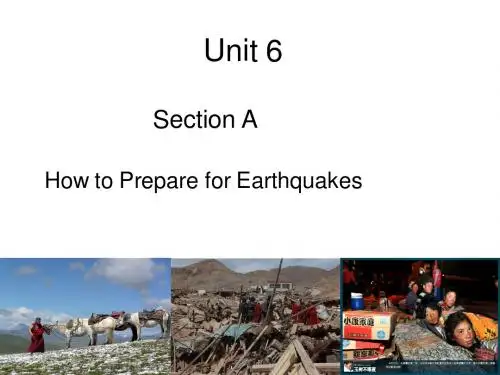
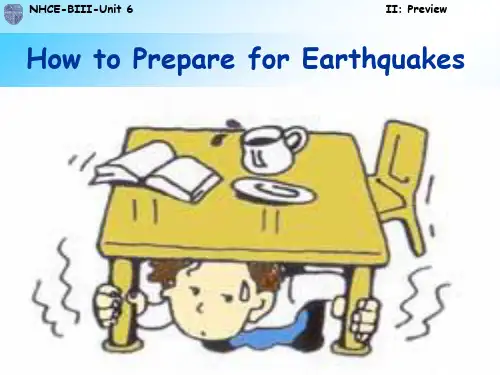
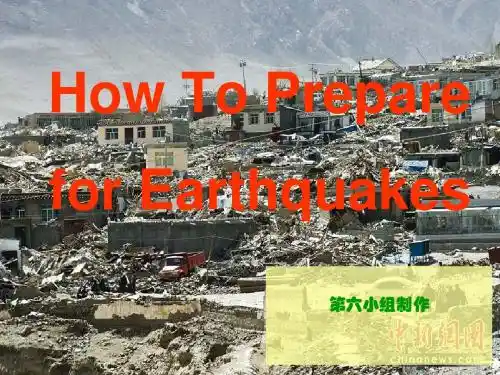
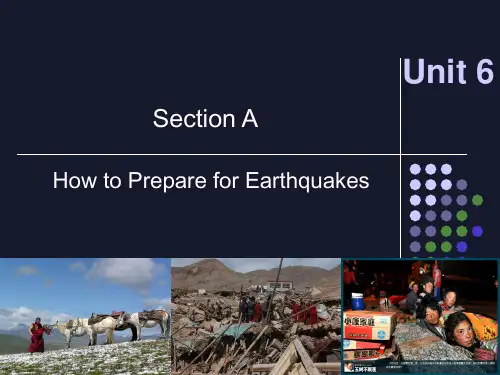
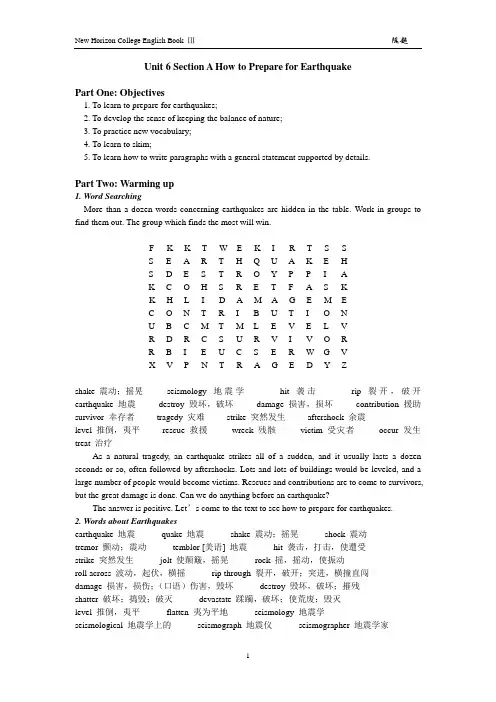
Unit 6 Section A How to Prepare for EarthquakePart One: Objectives1. To learn to prepare for earthquakes;2. To develop the sense of keeping the balance of nature;3. To practice new vocabulary;4. To learn to skim;5. To learn how to write paragraphs with a general statement supported by details.Part Two: Warming up1. Word SearchingMore than a dozen words concerning earthquakes are hidden in the table. Work in groups to find them out. The group which finds the most will win.F K K T W E K I R T S SS E A R T H Q U A K E HS D E S T R O Y P P I AK C O H S R E T F A S KK H L I D A M A G E M EC O N T R I B U T I O NU B C M T M L E V E L VR D R C S U R V I V O RR B I E U C S E R W G VX V P N T R A G E D Y Zshake 震动;摇晃seismology 地震学hit 袭击rip 裂开,破开earthquake 地震destroy 毁坏,破坏damage 损害,损坏contribution 援助survivor 幸存者tragedy 灾难strike 突然发生aftershock 余震level 推倒,夷平r escue 救援wreck 残骸victim 受灾者occur 发生treat 治疗As a natural tragedy, an earthquake strikes all of a sudden, and it usually lasts a dozen seconds or so, often followed by aftershocks. Lots and lots of buildings would be leveled, and a large number of people would become victims. Rescues and contributions are to come to survivors, but the great damage is done. Can we do anything before an earthquake?The answer is positive. Let’s come to the text to see how to prepare for earthquakes.2. Words about Earthquakesearthquake 地震quake 地震shake 震动;摇晃shock 震动tremor 颤动;震动temblor [美语] 地震hit 袭击,打击,使遭受strike 突然发生jolt 使颠簸,摇晃rock 摇,摇动,使振动roll across 波动,起伏,横摇rip through 裂开,破开;突进,横撞直闯damage 损害,损伤;(口语)伤害,毁坏destroy 毁坏,破坏;摧残shatter 破坏;捣毁;破灭devastate 蹂躏,破坏;使荒废;毁灭level 推倒,夷平flatten 夷为平地seismology 地震学seismological 地震学上的seismograph 地震仪seismographer 地震学家aftershock 余震smaller tremors 小地震epicenter 震中magnitude 震级Richter Scale (1—10) 里氏震级earthquake monitoring 地震监控tsunami 海啸tsunami warning system 海啸预警系统tidal waves 潮汐波,浪潮tragedy 灾难wreckage 残骸death toll 死亡人数survivors 幸存者victims 受灾者international contributions 国际援助evacuation 撤离rescue team 救援小组3. More Earthquake-related Word Gamemagnitude 震级intensity 加强epicenter 震中hypocenter 震源waves 震波shaking 震动fault 断层tsunami 海啸4. What does a strong earthquake bring to us?1) It brings instant ruin upon the fruits of our labor, such as…;2) It gives rise to secondary disasters like…;3) It takes a heavy toll of human lives, as in…;4) It gives us a great insight into…;5) …;What a strong earthquake brings us is nothing but nightmare. In the first place, it brings instant ruin upon the fruits of our labor, such as high-rise structures, water works, electric network, telecommunications system, and traffic facilities. In the second, it gives rise to secondary disasters, like tsunamis, landslides, fires, barrier lakes, and eruptions of volcanoes. In 2004, for example, the tsunami following an earthquake killed over 227, 000. In the third, it takes a heavy toll of human lives, as in the earthquake that struck Tangshan in 1976, killing over 255,000, the greatest death toll from a single earthquake in the last four centuries. And worst of all, it gives the survivors a great insight into the impact of panic, which they may live with all the rest of their lives.5. How to predict a strong earthquake?1) Seismic patterns?2) Weather conditions?3) Radon or hydrogen gas content of soil or ground water?4) Water level in wells?5) Animal behavior?6) …?6. How to prevent great damage caused by a quake?1) Know the history of local earthquakes;2) Keep informed of where fault lines lie;3) Get familiar with local seismic hazards;4) Be clear in mind about what to use for your new building;5) Identify the weak points in your old building and reinforce them;6) …To prevent the great damage caused by a strong earthquake, you have much work to do. First, you must have a clear idea about the history of local earthquakes, keep informed of where fault lines lie, and get familiar with your local seismic hazards, so as to know what materials to use for your new building, such as fiberglass roofing instead of concrete tiles, and how to make the building flexible enough to prevent it from crumbling when tremors occur. Second, you must identify the weak points in the old building you live in and reinforce them to such an extent that it will not collapse at the moment of sharp quake or at least remain strong enough for your escape. But that is far from enough to ensure your good survival in the event of a terrible earthquake.7. How to prepare ourselves well for a big earthquake?Before an earthquake: 1) Keep handy a survival kit, in which …;2) Know the safe locations in your home;3) Arrange for the way of family unity;During an earthquake: 4) If outdoors, get away from high objects;5) If indoors, stay away from windows;6) If driving, pull over and stop;To survive a terrible earthquake, you have to prepare a survival kit, in which are supplies including food, water, flashlight, batteries, radio, medicines, first aid kit, money and clothing. You have to be clear about the safe as well as danger spots in your home so as to know where to stay in the event of a big quake. You also have to decide how to get your family reunited after the outbreak of an earthquake. During an earthquake, if outdoors, you should get into an open area away from trees, buildings, walls and power lines; if indoors, stay away from windows and outside walls, and get under a table; and, if driving, pull over and stop, avoiding overpasses and power lines. You must also get your family prepared for aftershocks and other secondary disasters such as landslide.Part Three: Related Information1. The 1906 San Francisco EarthquakeAt 5:13 on the morning of April 18th, 1906, the city of San Francisco was shaken by a terrible earthquake. A large part of the city was destroyed and a large number of buildings were burnt. The number of people who lost homes reached as many as 250, 000. About 700 people died in the earthquake and the fires.Another earthquake shocked San Francisco on October 17th, 1989. It was the second strongest earthquake and about one hundred people were killed. It happened in the evening as people weretraveling home. A wide and busy road fell onto the below. A lot of people were killed in their cars, but a few lucky ones were not hurt.Luckily the 1989 earthquake did not happen in the center of town but about 50 kilometers away. In one part of the town many buildings were destroyed. These buildings were over 50 years old, so they were not strong enough. There were a lot of fires all over the city. The electricity was cut off for several days too.Scientists explain that the outside of the earth is made of different plates. At San Francisco the Pacific plate meets the North American plate. When suddenly these two plates jump, an earthquake is felt. When the 1906 earthquake happened, the Pacific plate jumped 5-6 meters to the north.We cannot stop earthquake, but we can do things to make sure they do not destroy a whole city. First, it is not a good idea to build houses along the lines where two of the earth’s plates join together. Second, if you think there may be an earthquake, it is better to build houses on rock not on sand. Third, you must make the houses as strong as possible. Weak buildings will fall down in an earthquake, but strong ones may stay up.Scientists are afraid that one day an even bigger earthquake will hit the area around San Francisco. They call it “The Big One”. However, people today are still building more houses. The population in and around San Francisco is now ten times more than it was in 1906. This means that if there is another big earthquake, a great many houses and buildings will be destroyed.2. The 1976 Tangshan Earthquake1) Which city earns the name “Brave City of China”? Tangshan2) The deadliest earthquake of the 20th century, a magnitude 7.8 earthquake hit the sleeping city of Tangshan at 3:42 a.m. on July 28, 1976.3) Which of the following gave some advance warnings of an impending earthquake?A. Well water rose and fell with cracking or gas.B. Chickens refused to eat and ran around chirping.C. Mice and yellow weasels ran around to hide.D. A goldfish jumped wildly in its bowl.E. Strange lights (fireballs) as well as loud sounds were seen the night preceding the earthquake.4) The Tangshan earthquake lasted approximately 14-16 seconds. After the earthquake hit, 242419 people were dead or dying; 164581 people severely injured. In 7218 households, all members of the family were killed by the earthquake.5) Over two million people died in the earthquake in the 20th century. About 0.6 billion people live in the strong earthquake zone throughout the world.6) 93 percent of the residential buildings and 78 percent of the industrial buildings were completely destroyed.3. The Great Hanshin Earthquake DisasterMeasured 7.3 on the Richter Scale, the earthquake occurred on January 17, 1995 in the southern part of Hy-go Prefecture and lasted for approximately 20 seconds. The epicenter of the earthquake was on Awaji Island, near the cosmopolitan city of Kobe with a population of 1.5 million. Over 6,000 people, mainly in Kobe, lost their lives. Additionally, it caused approximately ten trillion yen (1$200 biuion USD) damage earthquake in 1923, which claimed 140,000 lives. This earthquake was listed in the as the “costliest natural disaster to befall any one country”.4. What’s your insight into earthquakes?Because they have no warning and allow people no time to react to them in an effective way. As described in the video, one second you live in this big beautiful city and ten seconds later it is flat. So on any scale of instant destructivity, few natural disasters can come close to earthquakes. At 11:43 A.M. on June 7, 1692, for example, an earthquake struck Port Royal, Jamaica. In the space of less than fifty seconds, that thriving port sank into the Caribbean. An eyewitness described the scene. “In many places the earth cracked, opened and shut, with a motion quick and fast. People were swallowed up; in others they were caught by the middle, and pressed to death.”In the 17th and 18th centuries, it was believed in the Western world that because earthquakes normally occurred in non-Christian countries, they were signs of God’s anger with the inhabitants of these areas. In fact, every day the earth is shaken by hundreds of small earthquakes, most going unnoticed. They usually occur along the boundaries of thin plates that cover the earth like egg shells. Driven by the heat deep within the earth’s core, plates grind against each other along lines called faults. When plates find their motions blocked, stress builds up. Finally the fault gives way. Released energy races through the earth in a form of seismic waves (震波) and a quake occurs. 5. How much do you know about other natural disasters?In addition to the earthquake, the human society as a whole is also cursed with a long list of other natural disasters, among which are flood, mud-rock flow (泥石流), landslide (山体滑坡), typhoon, hurricane (飓风), tornado (龙卷风), snowstorm (暴风雪), hailstorm (冰雹), sand storm (沙尘暴), drought (干旱), plague of locusts (蝗灾), the spread of desert, the spread of infectious diseases such as SARS (非典), and volcanic eruptions (火山喷发), the most famous example of which is the Great Pompeii, quickly covered with volcanic ashes.The contributors to these natural disasters are complex and varied. Some disasters such as earthquakes and volcanic eruptions result from the movement of plates along the weaknesses in the Earth’s crust. Many others, like flood, sand storm, and the spread of desert, stem from human activities. Man’s mindless enthusiasm for unrestrained economic growth has led to a sharp decline of forestry, a rapid desertification of farming land, an irreparable depletion of ozone layer, a global worsening of greenhouse effect, and a swift extinction of species, all of which in turn bring about more disasters.Part Four: Text UnderstandingI. Idea CatchingThe Birth of the TextPrediction: It is far from perfect though it is better for people to know more about it. Prevention: To prevent great damage, people need to take more care of their houses. Preparation: To survive a big quake, people need to prepare themselves in great details. Author: He sees it as vital for people to know well about the whole thing.1. How can we know about warning signs of earthquakes?1) Wire the earth and sea …2) Watch animals and plants …3) The amount of radon waxes …2. What animals show what signs of earthquakes?1) hens—cages 2) snakes—freeze 3) dogs—bark a lot 4) fish—surface5) birds—noisy—fly unusuallySome advance warnings of an impending earthquake.A. Well water rose and fell with cracking or gas.B. Chickens refused to eat and ran around chirping (吱喳而鸣).C. Mice and yellow weasels (黄鼠狼) ran around to hide.D. A goldfish jumped wildly in its bowl.E. Strange lights (fireballs) as well as loud sounds were seen the night preceding the earthquake.3. How are most of the people killed in an earthquake?By falling buildings.4. What building structures might prevent the great destruction of property?1) Steel joint/an I-joint2) Equally strong columns & horizontal beams3) Deep vertical support columns4) Light roofs & strong walls5. What should people do to prepare their houses?1) Check/reinforce homes …2) Place heavy objects …3) Attach cupboards & cabinets …4) Fasten doors …6. What should people need for their earthquake survival supplies, and why?water & food radio receiver torch extra batteries first-aid supplies spade tent rope clothing fire extinguisher auxiliary cooking & heating sourceheavy shoes or boots7. How can family members keep in touch during an earthquake?Check in with a far-away fr iend or relative…8. What should be a major emphasis for all government programs and earthquake-related research projects?Education concerning how to survive an earthquake.II. Structure Analysis1.What is the text mainly about?The essay is centered around the main theme —How to predict, prevent, and prepare for earthquakes.2.How is the text organized?The writer centers his writing on three aspects of the topic—earthquake prediction, earthquake prevention, and earthquake preparation. In the end, he concludes his writing with more emphasis placed on people’s preparation for earthquakes. So the text can fall structurally into four parts. Part I Prediction Main idea: People predicted a quake by wiring the earth and sea to detect movements, watch-ing animals and plants for warning signs; and seeing if the amount of radon (Rn) in the water under the surface of the Earth waxes before an earthquake.Devices for developing it: Exemplification: (Para. 1) In Japan, scientists have wired the Earth and sea…The Chinese have traditionally watched animals and plants for…For example, …Before the Hansin earthquake in Japan, …Part II Prevention Main idea: To prevent buildings from threatening our lives, new structures need to be built with an I-joint steel, with columns and horizontal beams of equal strength, and with light roofs; and pillars for highway bridges need to be enclosed in steel.Devices for developing it: Deduction: (Para. 2) General Statement: People would also like to…prevent…Details: 1) Most people are killed by…2)…with steel joint; 3)…of equal strength 4)…enclosed in steel.Part III Preparation Main idea: To prepare for a great quake, you need to keep survival supplies at home and at work; have proper tools ready at hand; make sure what to do in case of a quake; and plan for family re-unity.Devices for developing it: Deduction: (Paras. 4-6) General statement: People …need to prepare themselves. Details: 1) …have supplies of water and food…; 2) Have a fire extinguisher handy; 3) Every family needs to have earthquake emergency plans.Part IV Conclusion Main idea: Even if prediction becomes possible, people still have to do their best to prevent disasters by improving building structures and by being personally prepared.Devices for developing it: Induction: (Para. 7) Known facts: 1) …scientists learn much about how quakes work; 2) It will be possible to predict quakes with accuracy; 3) But people still have to prevent quakes. Conclusion: Education concerning …should be a major emphasis for all …projects.Part Five: Notes To The Text☆New words and expressions1. to watch sth. for…/ to watch for 观察某物以获取······/ 小心等待他一直在等待着恰当的时机来表达对她的爱慕之情。
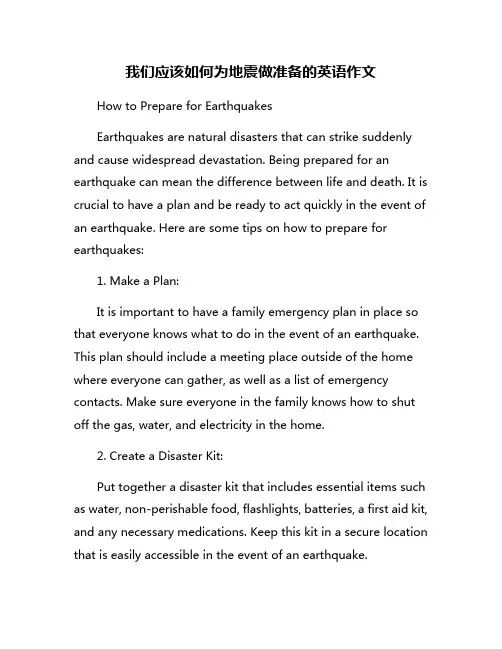
我们应该如何为地震做准备的英语作文How to Prepare for EarthquakesEarthquakes are natural disasters that can strike suddenly and cause widespread devastation. Being prepared for an earthquake can mean the difference between life and death. It is crucial to have a plan and be ready to act quickly in the event of an earthquake. Here are some tips on how to prepare for earthquakes:1. Make a Plan:It is important to have a family emergency plan in place so that everyone knows what to do in the event of an earthquake. This plan should include a meeting place outside of the home where everyone can gather, as well as a list of emergency contacts. Make sure everyone in the family knows how to shut off the gas, water, and electricity in the home.2. Create a Disaster Kit:Put together a disaster kit that includes essential items such as water, non-perishable food, flashlights, batteries, a first aid kit, and any necessary medications. Keep this kit in a secure location that is easily accessible in the event of an earthquake.3. Secure Furniture and Heavy Objects:One of the biggest dangers during an earthquake is falling objects. Make sure to secure heavy furniture, bookshelves, and other objects that could fall and cause injury. Use earthquake straps or putty to secure items to walls or floors.4. Know Your Home's Weak Points:Every home has weak points that are more vulnerable to earthquake damage. Know where these weak points are in your home and take measures to reinforce them. This could include securing your foundation or anchoring your chimney.5. Stay Informed:Keep abreast of any earthquake warnings or alerts in your area. Follow news updates and listen to emergency broadcasts for information on how to stay safe during an earthquake. It is also a good idea to sign up for text alerts from your local emergency management agency.6. Practice Earthquake Drills:Just like fire drills, it is important to practice what to do in the event of an earthquake. Conduct earthquake drills with your family members so that everyone knows how to react and can act quickly and efficiently in an emergency.7. Have a Communication Plan:In the event of an earthquake, it is essential to have a communication plan in place. Make sure everyone in your family knows how to contact each other in case of separation. Designate an out-of-town contact person who can help coordinate communication if local lines are down.8. Be Prepared to Evacuate:In some cases, it may be necessary to evacuate your home in the aftermath of an earthquake. Be prepared to leave at a moment's notice and have a go-bag ready with essential items such as identification, money, and important documents.9. Stay Calm:During an earthquake, it is important to remain calm and stay focused. Panic can lead to poor decision-making and increase the risk of injury. Stay low to the ground, take cover under a sturdy piece of furniture, and hold on until the shaking stops.By following these tips and being proactive in your earthquake preparedness, you can increase your chances of staying safe in the event of a disaster. Remember, being prepared is the best defense against earthquakes.。
